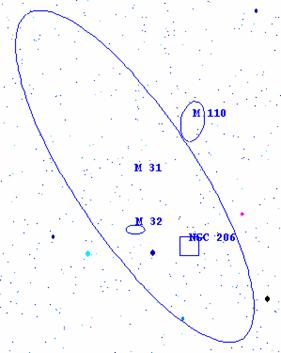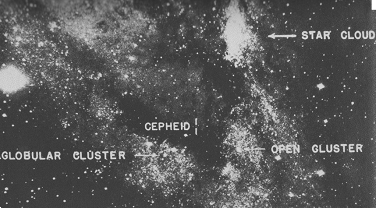Visual Primer on M31
Jack Kramer
Of all the deep sky objects accessible to those of us in the Northern Hemisphere, M31 - the "Andromeda Galaxy" - is one of the most often observed by amateur astronomers. No doubt you've looked at it many times. But for those who have viewed it as not much more than a fuzzy patch, here are some suggestions that may increase your enjoyment of this island universe.
First, a little background. M31 is a member of the Local Group; at about 2.5 million light years distant, it's the nearest spiral galaxy to the Milky Way. Specifically, it's classed as a barred spiral. It's estimated to be more than 260,000 light years in diameter, although its exact size, distance and shape have long been subjects of debate. While recent estimates place M31 more than twice as large as the Milky Way, astronomers tell us that it's a good analog for how our own galaxy might look if we were able to see it from afar. For more info, go to: http://www.seds.org/messier/m/m031.html
The two dark lanes on the same side of the galaxy stand out well, one being nearer to the central hub. It's common to see these in telescopes of six-inch aperture under dark skies. But in suburban skies it may take more light gathering ability. About twenty years ago when I upgraded from an eight to a ten-inch Newtonian, M31 was the first object I observed with the new scope; I noticed immediately that the dark lanes became easier to see from the suburb where I lived at the time. It's also a common impression that we're seeing stars "through" the dark lanes, but these are foreground stars lying within the Milky Way - the dust lanes themselves are quite opaque. The following is an image I took through my 6" refractor and "softened up" to look the way M31 usually appears visually through about a 10-inch telescope in a dark sky.

Unless you're using a very wide field telescope/eyepiece combination, you're not going to be able to capture the entire galaxy in a single field of view. Many first-time observers see an oval fuzzy patch and assume that's the extent of the galaxy, when in fact they're only seeing the central hub. This galaxy is so large that we have to move our telescopes around to glimpse the edges that gradually fade from view. The following chart from the Guide computer program shows the total extent of the galaxy, which has a very faint halo that extends well beyond what our telescopes are capable of showing. Studies have shown that the reason this stellar halo is so faint is that its density is quite low - notably lower than the halo of stars in the outskirts of the Milky Way.

There are two satellite elliptical galaxies - M32 and M110. M32 appears as a small fuzzy patch near the central hub of M31; the larger M110 is a bit farther from the hub. Some observers claim that M110 is the easier of the satellite galaxies, but I've always found M32 to be the more obvious of the two. In a badly light polluted sky, M110 is often not visible at all. Both satellite galaxies have the same integrated magnitude (8.1), but they differ in surface brightness. M32 is 8x6 arc minutes in size, while M110's light is spread out more because of its larger size - 17x10 arc minutes. Note that in the above chart M32 is actually superimposed over the envelope of M31. (The term "envelope" is used to describe the entire luminous surface of a galaxy.) Since our telescopes can't show the very faint outer halo of the galaxy, for us M32 is seen well off to one side.
Another feature is NGC 206, a large star cloud that lies within M31 toward the southwestern edge of the spiral arms. It appears as a slightly brighter patch. In dark skies I've seen it easily in a 6-inch refractor. The diagram above can serve as a guide for where to look.
With a sufficiently large telescope, it's possible to pick up some additional deep sky objects that are actually located within M31. After the large star cloud, probably the next easiest is the open cluster shown in the Mount Wilson 100-inch photo below. (The "star cloud" in the photo is NGC 206.) As you can see, there are a number of stellar concentrations and foreground stars that could easily be confused with the open cluster, so this calls for careful observing. Using averted vision also helps. I can't say that I've ever identified it, but I'm still trying!

For those seeking a real challenge, there are about ten globular clusters in M31 that are said to be visible to amateur astronomers with dark skies and large enough telescopes. Probably the easiest of these is the one shown in the above photo. Veteran observer Steve Coe in Arizona spotted five of the globulars using a 171/2" scope. A detailed photographic finder chart is definitely needed. Here's one of them available on the Internet: http://dvaa.org/AData/M31GC.html
It's unfortunate that some observers see M31 as just a glowing patch of light, then soon move on to another target. In fact, there are many details that can be teased out. I find that more detail is visible using my widest field eyepieces in order to present a large-scale view. Obviously, it's best observed when fairly high in the sky to avoid looking through a lot of the Earth's atmosphere. And, of course, you'll see more if you observe from a dark site. Unfortunately, no one has yet invented a filter to improve the view of galaxies!
Published in the October 2007 issue of the NightTimes




